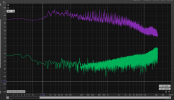jmf11
Member
Hello,
I try to get some understanding of which power is needed in active speakers to achieve a SPL level at defined listening distance. I fist checked the datasheets of products like Neumann monitors or JBL 305P (and for KH80 and JBL 305P we know which amp chips are used).
I did some home work to learn the basis (https://audioxpress.com/article/target-spl-and-required-amplifier-size) and found an online calculator: http://www.mh-audio.nl/Calculators/REAP.html
I wonder:
Which "combinations" would we expect in Active Monitors?
A STA350BW amp (the one inside the JBL) stays in 6R below 0.1% THD+N up to 2x10W (but is rated 2x50W). Using a Woofer with a 85 dB sensitivity, using the Calculator, I would achieve 74 db SPL at 2m (1 woofer - 10W). Using the 2x50W figure (10% THD+N), It would achieve 81 dB at 2m. Which is the more realistic assumption ?
Best regards,
JMF
I try to get some understanding of which power is needed in active speakers to achieve a SPL level at defined listening distance. I fist checked the datasheets of products like Neumann monitors or JBL 305P (and for KH80 and JBL 305P we know which amp chips are used).
I did some home work to learn the basis (https://audioxpress.com/article/target-spl-and-required-amplifier-size) and found an online calculator: http://www.mh-audio.nl/Calculators/REAP.html
I wonder:
- which amplifier headroom / crest factor to consider. I understand that 15 dB is a safe bet for music (uncompressed. What do you use?
- to which figure from amplifiers datasheets to consider for the power: Output power THD+N: 10% ? 1%? 0.1%?
- I imagine that with 15 dB Crest factor, the Crest values are rarely hit and high distorsion would apply to a minor part of the signal. But is this true?
Which "combinations" would we expect in Active Monitors?
A STA350BW amp (the one inside the JBL) stays in 6R below 0.1% THD+N up to 2x10W (but is rated 2x50W). Using a Woofer with a 85 dB sensitivity, using the Calculator, I would achieve 74 db SPL at 2m (1 woofer - 10W). Using the 2x50W figure (10% THD+N), It would achieve 81 dB at 2m. Which is the more realistic assumption ?
Best regards,
JMF



